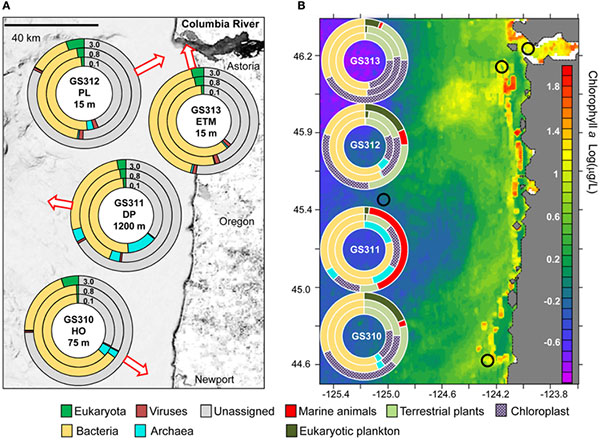You are here
CMOP Publication is Top 10 Most Viewed Microbiology Research Article in 2013
01/24/14 Portland, Ore.
 Domain composition of metagenomes—arrows indicate approximate water sampling locations upon the underlying contour map. Contrasting genomic properties of free-living and particle-attached microbial assemblages within a coastal ecosystem, a journal article by Holly Simon, Ph.D. and her research team, is ranked as one of the top 10 most viewed from Frontiers in Microbiology in 2013.
Domain composition of metagenomes—arrows indicate approximate water sampling locations upon the underlying contour map. Contrasting genomic properties of free-living and particle-attached microbial assemblages within a coastal ecosystem, a journal article by Holly Simon, Ph.D. and her research team, is ranked as one of the top 10 most viewed from Frontiers in Microbiology in 2013.
Dr. Simon, a scientist with the Center for Coastal Margin Observation and Prediction (CMOP) and professor at Oregon Health & Science University's Institute of Environmental Health, collaborated with the J. Craig Venter Institute to characterize the microbial diversity within the Columbia River estuary.
“We sequenced the total DNA from water in four habitats: the Columbia River's immediate outflow; the river plume that extends into Pacific Ocean; upwelling low-oxygen water off the coast; and the ocean bottom,” Simon said.
Their research shows the Columbia River estuary as a complex region characterized by high turbidity ("cloudiness"), in which bacteria attached to solid particles suspended in the water are crucial for recycling organic matter.
Paradoxically, the turbidity blocks sunlight in these estuarine waters and makes it difficult for photosynthetic algae to grow there, yet light-dependent bacteria dominate these waters. These bacteria are known as photoheterotrophs because they use both organic substrates and light energy for growth and survival. They employ a protein that is related to light-sensitive pigments in mammalian eyes to generate energy from light, which helps them survive when nutrients are scarce. Habitat diversity, in the form of local variation in size and type of suspended particles, maintains the considerable bacterial biodiversity in the estuary of the Columbia River.
The research article was published in Frontiers, a community-oriented open-access academic publisher and research network. They are the fastest-growing open-access scholarly publisher, with a rapidly growing number of community-driven journals, more than 25,000 of high-impact researchers across a wide range of academic fields serving on the editorial boards and more than 4 million monthly page views.
Read the journal article on Frontiers website.
Written by Jeff Schilling






